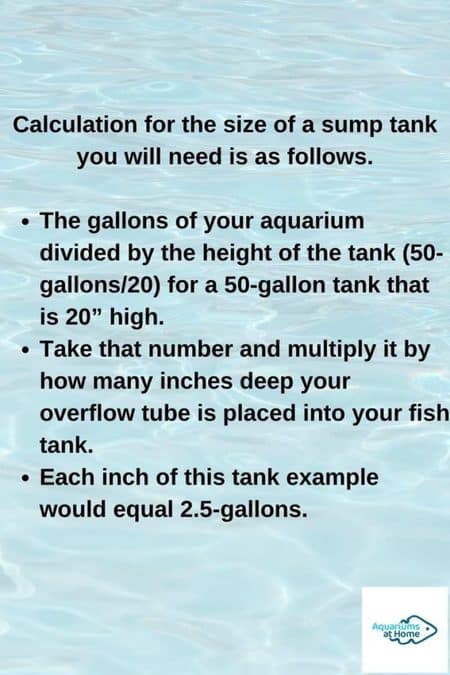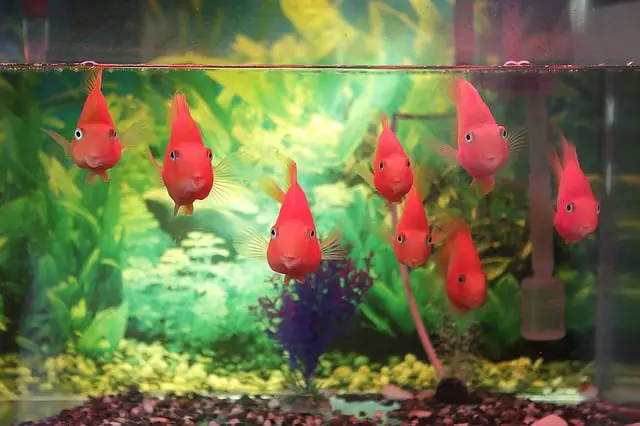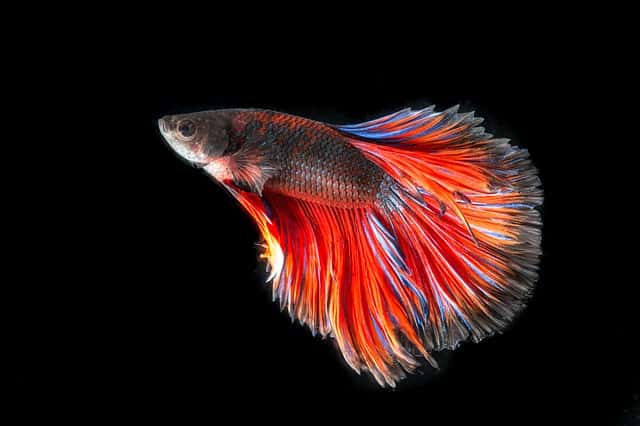If you’re new to the aquarium hobby or have primarily been keeping freshwater fish, you might associate using a sump with marine tanks – assuming you have heard of an aquarium sump. Traditionally, sumps have been set-up by marine hobbyists. What does that mean for freshwater aquarium owners, however?
A sump can be used for tropical fish. Using a sump with a freshwater fish tank is a great idea. There are benefits to using a sump with tropical fish. The benefits include (but aren’t limited to): increased filtration area; better aeration; a less cluttered aquarium; easier maintenance; easier addition of chemicals; more stable water parameters.
If you have the space and equipment available, then hooking up a sump tank to your tropical fish tank is an excellent idea. Once it is set-up and running for a couple weeks, you’ll be amazed at just how much better your fish tank runs.
This article will touch on why you might want to use a sump tank for a freshwater aquarium and a few other items that would be important to know, especially if you’re new to the hobby or sump tanks. Let’s get started.
Why Use a Sump Tank for a Freshwater Fish Tank?
Years ago, in the aquarium hobby, sump tanks and freshwater tanks were never mentioned in the same sentence. As the hobby has advanced over the past few decades, fish owners like yourself are gaining much more knowledge about taking care of tanks and fish.
By adding another tank to use as a sump, you’re adding that much more water volume to your main tank. This means you’ll have surface area for gas exchange. Aeration will never be a problem for your tank anymore.
Your filtration can now reside in the sump tank. You can build a custom filter or purchase one, but I highly recommend building one. Since you’ll need a water pump like these ones over on Amazon, you can easily build a filter chamber just before the pump.
This will allow you to increase your beneficial bacteria exponentially. I highly recommend going this route.
Your aquarium will now be less cluttered. With a sump tank, you’ll keep your heater and filtration there which frees up space in your fish tank. If you had a marine tank, you would have a protein skimmer in the sump as well.
Maintenance will be easier and less invasive to your fish as it can be done in the sump tank instead of the aquarium. This means less stress for the fish.
As you’ll have much more water volume than your display fish tank holds, your water parameters will be more stable. The health of your tank will improve just by having a sump tank set up.
How Big of a Sump Do I Need for My Aquarium?
You might think this is a complicated or confusing calculation, but it isn’t thankfully.
To understand how big of a sump tank you need for your specific set-up, you must first understand the very simple process in how water goes from your main tank to a sump tank and then back out into your main tank again.
Once you understand this, the rest is quite simple. Here we go.
- A sump tank has a tube that brings water from the main tank and another tube that forces water back out into the main tank.
- The tube that takes water from the tank to the sump is basically an overflow.
- The tube that’s forcing water back into the main tank is hooked up to a water pump.
- To figure out what size your sump should be, you need to focus on the overflow tube and how much water it is taking out of your tank.
- Overflow tubes are usually about 2” below the surface.
- Once you know how deep your overflow tube is, you can easily calculate how many gallons of water it’ll allow to flow out into your sump.
- Let’s use a 50-gallon tank as an example that measures 36” wide by 15” from front to back and 20” high.
- If the tank is 20” high and it is a 50-gallon aquarium, you can calculate that each inch of depth is equal to 2.5-gallons of water.
- This would mean that an overflow tube at a depth of 2” on a 50-gallon tank with the same dimensions as above would let a maximum of 5-gallons of water flow out.

This means if you had the same sized tank as above, you would need at minimum a 5-gallon sump. If you set the overflow tube deeper in your fish tank, you would need a larger sump tank.
Now this example shows what the absolute minimum size of a sump tank is that you would need. We both know that a 5-gallon sump is very small.
What I would also consider on top of water volume is the size of filtration you want to add and maybe more important is how much room you have available and what you can afford.
My recommendation for a sump tank on a 50-gallon aquarium is a minimum of 20 gallons. This allows room for expansion on filtration and enough extra water volume to make it worth your while. That said, if you can add a 40-gallon tank as a sump, then go for it.
At What Size Tank Should You Consider Using a Sump Tank?
Old school hobbyist thinking is that once you get up to around the 50-gallon tank size, you should consider setting up a sump tank.
You should set-up a sump when you want to. If you’re thinking about it now, then whether you have a 20 or 70-gallon aquarium, go ahead and set one up.
Years ago, people didn’t set sumps up on smaller tanks, possibly because they didn’t realize the high value a sump is to on any aquarium setup. My theory is that smaller tanks didn’t get sumps connected because smaller tanks can be situated in places where, if you connected a sump, it couldn’t be easily hidden and out of site.
I have a 10-gallon on a sofa table that has wrought iron legs and the underneath of the table is completely exposed. There’s no way I’m setting up a sump under that tank as it would be an eye sore in my living room.
Much larger tanks typically have cabinet style stands or are set-up in or against a wall where a sump tank could easily be connected either from underneath in a cabinet or behind a wall.
To sum up this section – you can hook up a sump tank to any size aquarium.
What Media to Put in a Freshwater Sump?
This is the fun part of setting up a sump tank. In a sump, there will be more than one chamber. The first chamber can just be water then the next chambers can be filled with sponges, activated charcoal, filter floss, heaters, bio-cubes, and whatever other filter medium you can think of.
It’s a good idea to get your sponges and filter floss situated near the beginning of the sump tank sequence to clean out organic compounds.
Conclusion
To conclude this article, I want to point out the added value having a sump tank hooked up can be.
As previously stated, sump tanks improve the overall health of any fish tank. The increase of beneficial bacteria that a sump tank can provide will ensure a strong and healthy environment.
Aside from the added benefits of your tank being healthier, it’s important to point out that your fish tank should be a bit more clutter-free. The aesthetic appearance of your tank will improve just like its health.
If you have the room and the funds to do so, making an investment in a sump tank will be money well spent and not regretted.
Good luck!
Related Posts
Are Sponge Filters Good Enough for Aquariums? (Everything You Should Know)
How High Should the Water Level be in a Fish Tank?






